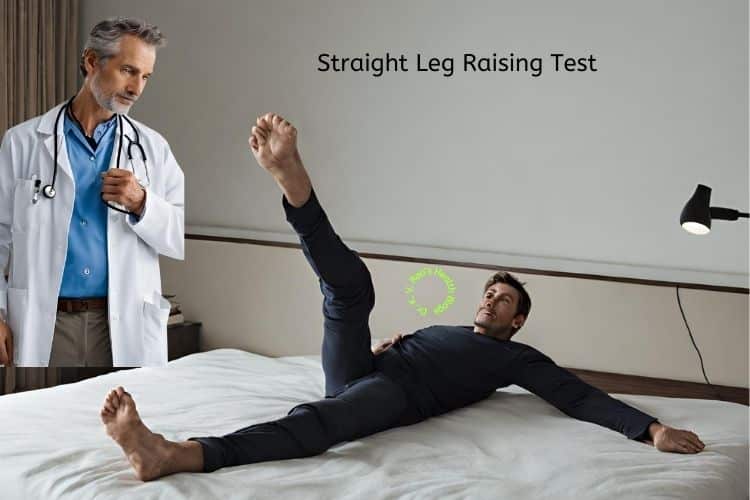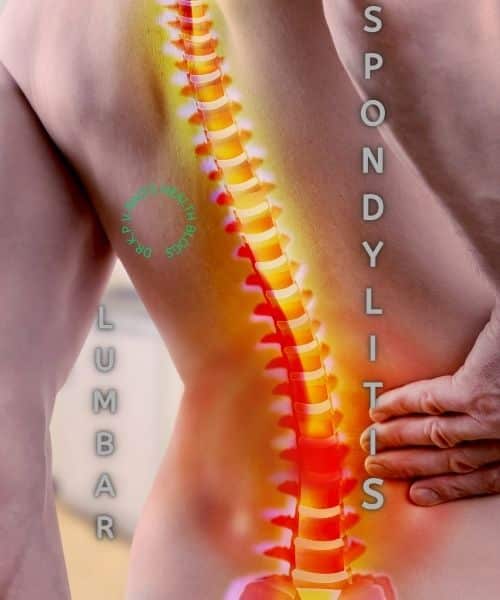Are you or someone you know experiencing persistent lower back pain? It could be a sign of lumbar spondylitis, a condition that affects millions worldwide. In this article, we will explore the causes, symptoms, and treatment options for managing lumbar spondylitis.
Table of Contents
What is lumbar spondylitis?
In my last article I published a detailed article on Cervical Spondylitis, a condition similar to the condition we are about to learn today. If you have not read so far, you can click below to do so-
Lumbar spondylitis, also known as spondylosis, is a degenerative condition that affects the lumbar spine (lower back).
The lumbar spine is made up of five vertebrae plus the sacrum, discs, and joints that provide support and flexibility. Over time, these structures can wear down due to age, injury, or repetitive stress, leading to lumbar spondylitis.
This condition is characterized by the gradual deterioration of the spinal discs and joints, resulting in chronic pain, stiffness, and reduced mobility.
Causes of lumbar spondylitis
There are several factors that can contribute to the development of this disease. Age is a significant factor, as the wear and tear of the spinal discs and joints tend to increase over time. Additionally, certain occupations or activities that involve repetitive movements of the back or heavy lifting can put excessive strain on the lower back, leading to the development of lumbar spondylitis.
Other risk factors include obesity, smoking, and a sedentary lifestyle.
Symptoms of lumbar spondylitis
The symptoms can vary from mild to severe, depending on the extent of the degeneration. The most common symptom is lower back pain, which can range from a dull ache to sharp, shooting pain.
This pain may worsen with movement, prolonged sitting, or standing for long periods. In some cases, the pain may radiate down the leg, causing sciatica. Numbness or tingling in the legs or feet may also be experienced.
Additionally, individuals with lumbar spondylitis may have difficulty standing or walking for long periods due to stiffness and reduced mobility.
Diagnosing lumbar spondylitis
If you suspect you have lumbar spondylitis, it is important to consult with a healthcare professional for an accurate diagnosis.
The doctor will typically begin by conducting a physical examination and reviewing your medical history. A straight leg test is done to rule out compression of nerves and disc prolapse, as shown below-

They may also order imaging tests such as X-rays, MRI scans, or CT scans to assess the condition of the lumbar spine and identify any degenerative changes or abnormalities. These diagnostic tests can help confirm the presence of this disease and determine the extent of the condition.
Treatment options for lumbar spondylitis – medication, physical therapy, and lifestyle changes
There are various treatment options available for managing lumbar spondylitis. In most cases, the goal of treatment is to relieve pain, improve mobility, and prevent further degeneration of the spine.
One commonly prescribed treatment is medication, which can include nonsteroidal anti-inflammatory drugs (NSAIDs) to reduce pain and inflammation, muscle relaxants to reduce muscle spasms, and analgesics for pain relief. However, it is important to consult with a healthcare professional before starting any medication.
Physical therapy is another effective treatment option for lumbar spondylitis. A physical therapist can design a personalized exercise program to strengthen the muscles supporting the spine, improve flexibility, and promote proper posture.
They may also incorporate techniques such as heat or cold therapy, ultrasound, or electrical stimulation to provide pain relief and reduce inflammation.
In addition to medication and physical therapy, lifestyle changes can play a significant role in managing lumbar spondylitis.
Maintaining a healthy weight is important to reduce the strain on the lower back. Regular exercise, such as low-impact activities like swimming or walking, can help strengthen the muscles and improve overall fitness.
It is also essential to practice good posture, avoid prolonged sitting or standing, and use proper body mechanics when lifting heavy objects.
Self-care tips for managing lumbar spondylitis
In addition to medical treatment and lifestyle changes, there are several self-care tips that can help manage lumbar spondylitis.
Applying heat or cold packs to the affected area can provide temporary pain relief and reduce inflammation.
Gentle stretching exercises, such as yoga or Pilates, can improve flexibility and relieve muscle tension. It is also important to listen to your body and avoid activities that exacerbate pain or discomfort.
Taking regular breaks and using ergonomic furniture [furniture that adjusts your sitting posture] or accessories can also help alleviate strain on the lower back.
Here is a short video that will show you how ergonomics work-
Alternative therapies for lumbar spondylitis – acupuncture, chiropractic care, and massage therapy
Alternative therapies can complement traditional treatment methods and provide additional relief for individuals with lumbar spondylitis.
Acupuncture, a form of traditional Chinese medicine, involves the insertion of thin needles into specific points on the body to promote healing and pain relief.
Chiropractic care focuses on spinal adjustments and manipulations to improve alignment and alleviate pain.

Massage therapy can help relax muscles, reduce tension, and improve circulation in the affected area.
Surgical options for severe lumbar spondylitis cases
In severe cases of lumbar spondylitis where conservative treatment methods have been ineffective, surgery may be considered.
Surgical options for lumbar spondylitis aim to decompress the nerves, stabilize the spine, and relieve pain.
Common surgical procedures include laminectomy, discectomy, spinal fusion, and artificial disc replacement.
However, surgery is typically reserved for individuals with severe symptoms or those who have not responded to non-surgical treatments.
Preventing and managing flare-ups of lumbar spondylitis
While lumbar spondylitis is a chronic condition, there are steps individuals can take to prevent or manage flare-ups. It is important to maintain a healthy lifestyle, including regular exercise, a balanced diet, and stress management.
Engaging in low-impact exercises and avoiding activities that strain the lower back can help prevent further degeneration. Additionally, practicing good posture, using ergonomic furniture, and taking regular breaks during prolonged sitting or standing can help alleviate strain on the lumbar spine.
FAQ
What is Lumbar spondylitis?
It is a condition characterized by inflammation and pain in the lower back region, specifically in the lumbar spine. It is often caused by the wear and tear of the spinal discs, leading to stiffness, discomfort, and restricted movement.
What are the common symptoms of Lumbar spondylitis?
Common symptoms include persistent lower back pain, stiffness, difficulty in bending or twisting, radiating pain down the legs (sciatica), muscle weakness, and numbness or tingling sensations in the lower extremities.
How is Lumbar spondylitis diagnosed and treated?
Diagnosis usually involves a combination of medical history review, physical examination, and imaging tests such as X-rays, MRI scans, or CT scans.
Treatment may involve a combination of pain management techniques, physical therapy exercises, medication to reduce inflammation, and in severe cases, surgical intervention to relieve pressure on nerves or stabilize the spine.
Note: It is important to consult with a healthcare professional for an accurate diagnosis and personalized treatment plan for Lumbar spondylitis.
What are some home remedies to treat lumbar spondylitis?
Some home remedies to treat this condition include:
Hot and cold therapy: Apply hot packs or take warm showers to relax muscles, followed by cold packs to reduce inflammation.
Exercise and stretching: Engage in low-impact activities like walking or swimming to strengthen the back muscles and improve flexibility.
Posture correction: Maintain good posture while sitting and standing to reduce strain on the spine.
Herbal remedies: Consider using herbal supplements like turmeric, ginger, or boswellia serrata to reduce inflammation.
Massage therapy: Regular massages can help alleviate pain and improve blood circulation in the affected area.
Yoga and meditation: Practice gentle yoga poses and meditation to promote relaxation, reduce stress, and improve overall well-being.
Weight management: Maintain a healthy weight to reduce pressure on the spine.
Ergonomic adjustments: Make ergonomic adjustments to your workspace and home to ensure proper back support and minimize strain.
Note: These remedies may provide relief but should not replace medical advice. Consult your healthcare professional for a proper diagnosis and treatment plan.
Conclusion
Lumbar spondylitis can significantly impact an individual’s quality of life, but with proper management, it is possible to reduce pain and improve mobility.
By understanding the causes, recognizing the symptoms, and exploring the various treatment options available, individuals with lumbar spondylitis can take control of their condition and lead a fulfilling life. Remember to consult with a healthcare professional for an accurate diagnosis and personalized treatment plan.
With the right approach, individuals can effectively manage lumbar spondylitis and enjoy a pain-free, active lifestyle.
Final Words
I hope I have solved all your doubts regarding lumbar spondylitis. If you have found it useful, do share it on social media icons below to promote Dr. K. P. V. Rao’s Health Blogs. You can also Click to Tweet here-
Managing Lumbar Spondylitis: Causes, Symptoms, and Treatment Options Share on XMy next article will be on a condition called Frozen Shoulder.
Adios.




